Milwaukee DSA is Building For Power through its public utilities campaign. Campaign leader Andy B shares how building a mass base will lead to a democratic, green energy future.
This interview has been edited for content and clarity.

GNDCC: What’s Milwaukee’s Building For Power campaign?
Andy B: Milwaukee’s GND campaign is called Power to the People. Our local private energy company, called We Energies, does not treat our community well at all—they made $1.3 billion in profits last year, and yet they are attempting to do the third rate hike in three years. Other publicly owned utilities in Wisconsin, which comprise about 11% of our power grid, have electric bills that are on average 30 to 40% lower.
We’re trying to replace We Energies with a publicly-owned, municipal power company. Our strategy to do this is through a particular Wisconsin law that gives the city a legal avenue to use eminent domain to purchase all of the private energy utilities in the city and convert them into public ones.
It requires the support of our Common Council in the city and will need to pass a referendum. A huge part of this campaign is building overwhelming community support for an initiative like this. There aren’t really any magic shortcuts; it takes a critical mass of public support demanding change from our city leaders for this sort of initiative to take place.
Why is public-owned power so important to the green transition?
Private companies like We Energies are driven by maximizing profit, and that’s not compatible with the rate of change we need to adopt green energy. Their idea of switching to more green energy is investing in a brand new billion-dollar natural gas power plant. They claim they want to reduce carbon dioxide (CO2) emissions by 80% by 2030 (compared to 2005 levels) and halt the use of coal as an energy source by the end of 2032, but there’s no accountability to actually ensure that happens. It’s not the bold action we need to see in the climate moment we’re in right now. A community-controlled, publicly owned power company gives the people of Milwaukee an actual say in how to transition to an ecologically sound power utility using solar and wind power.
Is there a particular reason why now is a good time for this public power campaign?
There is a funny bit of history in Milwaukee. This exact same legal avenue was pursued in the 1930s. They got further than we are right now; they actually went to a referendum and, unfortunately, that referendum failed. So here we are, almost 100 years later, trying it again, and better late than never. I wish it would have happened a lot sooner, but we’re gonna win this time.
Tell us about Milwaukee—what are the conditions like there and how do they affect this project?
Milwaukee, unfortunately, is a very geographically segregated city. The energy rate hikes overwhelmingly affect Black populations in this city. About 16% of the Milwaukee population is Black, but around 65% of residents who have a high energy burden are Black. It’s an issue that really affects marginalized communities, and that’s where we are especially succeeding in building our base for this campaign.
It does help that Milwaukee is, by and large, a very liberal city. So a lot of folks are already conditioned to understand the need to transition toward green energy and are on board with this specific plan that we can put in front of them. It’s a popular campaign, probably the most popular campaign I’ve worked on. Whenever we have canvassers go out pretty much anywhere in the city, folks are very receptive. I think it’s going to be a success.
It seems like it has a lot of popular support. What are some of the challenges that are facing this campaign?
The biggest, most immediate hurdle is that in order to actually get a referendum on our ballot to kick off this legal process, we need the support of the Milwaukee Common Council. We have 15 Common Council members. One of them is vocally in support of this campaign, and we’ve had a couple of the more kind of liberal progressive members who have basically implied that they’d be willing to support the campaign as soon as it becomes popular, as soon as it would start to benefit them politically. But we have quite a ways before we have a majority support on the Common Council.
That’s the most immediate hurdle, and even then, it is a complicated process. The referendum will need to pass, and we’ll need to make sure the community is educated against all the propaganda that We Energies is inevitably going to be pumping out. Maine, a few months back, had a state referendum to convert their entire power grid to a public power grid. And it failed, because the private energy corporations spent a ton of money to campaign against it. That is a tough hurdle to overcome.
This is a very, very long-term project. It’s popular, it’s fun, it’s exciting. The pitfall is it’s going to take a long time and a lot of effort.
How do you keep folks engaged when the fruition of the project is such a long-term thing?
One of my favorite ways we do that is by periodically hosting rallies and public-facing events. A month ago, we held an event at our city hall where we gathered all of the petitions that we’ve been collecting from folks around the communities expressing their support for the campaign. We had over 7,000 of them in this very large stack, and about 100 of us gathered outside City Hall and a very public rally, and we marched into City Hall and delivered them directly to the mayor and the Common Council. That’s the second time we’ve done that; the first time was when we only had 2,000 signatures. Events like that are really good for energy, and they keep folks aware of where the campaign is and engaged.
If someone was interested in running a similar public power campaign in a different chapter, what advice would you give them?
The most important thing is building that community support. There’s no magic sequence of making deals with elected officials or courting fundamentally “capital L liberal” folks into making this sort of radical change happen. You need the political will of an entire community to collectively demand it—that’s the most important aspect.
Additionally, find ways to not only fight for this campaign, but organize around it. An important aspect is that it does bring members into DSA, into our other projects. It does bring money and capacity into our chapter that we can use for this and other campaigns. It’s very important that this isn’t just a single campaign in a vacuum; it is part of something much larger.
Is there anything surprising that you’ve learned about public power through this process?
I didn’t realize how ubiquitous it was. Los Angeles, Memphis, Seattle; even here in Wisconsin, 11% of all power is public. I enjoy sharing that info with folks. Because, initially, it seems like such a pie-in-the-sky pipe dream that we can have a municipal power company, but it’s been tried and tested over and over again. It’s everywhere.
How can folks in Milwaukee get involved with your campaign?
The most important thing they can do, in my opinion, is join our canvases. We canvass all around Milwaukee every single Sunday. We also have phone banks every Thursday evening, where we call the folks who have signed our petitions and folks in DSA and invite them to join us in our efforts. Because that’s what it’s going to take. It’s going to take repetitive informing of the community, rallying of the community, organizing the community to make this project happen. So anybody interested in being a part of that process, I would love to see that.
